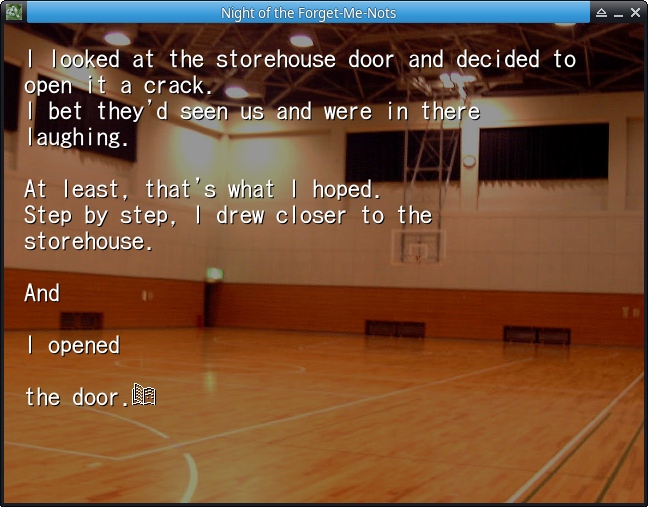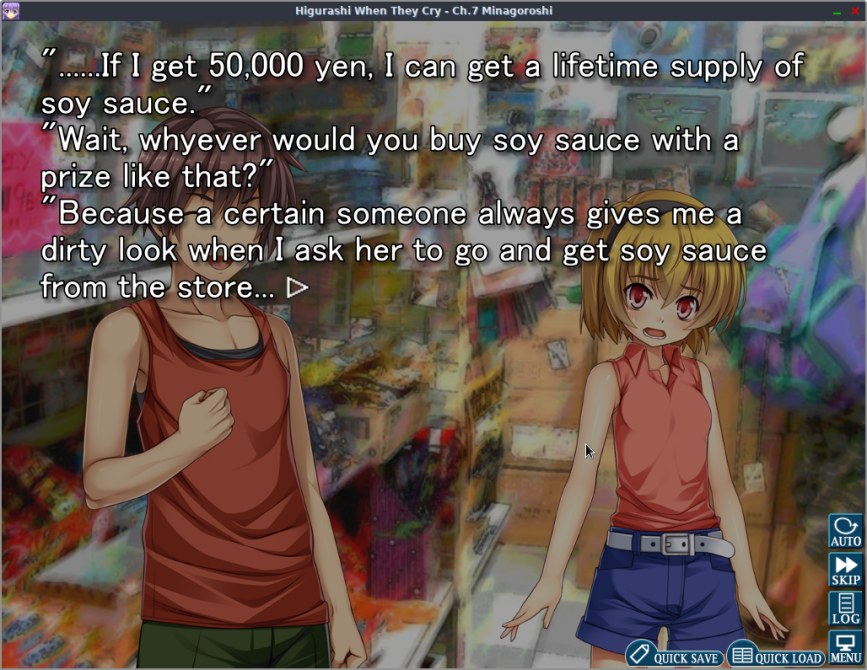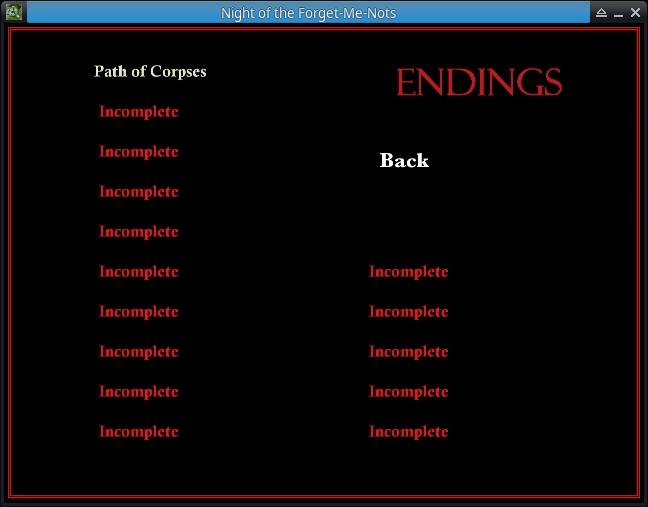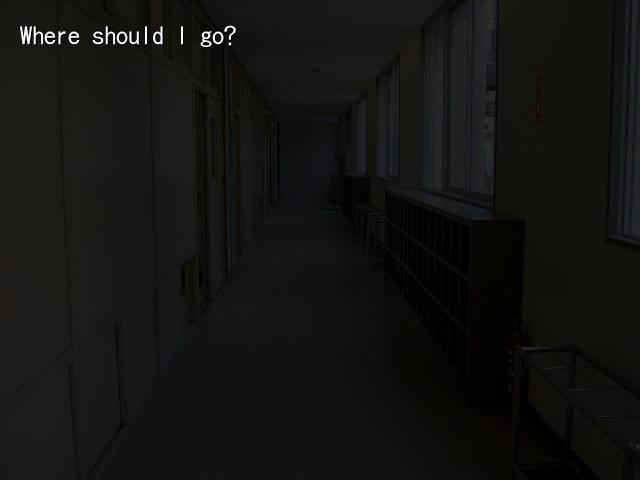Night of the Forget-Me-Nots is the unofficial English translation of Wasurenagusa no Yoru, a freeware horror visual novel first released in Japan in 2003. The English-language translation was contributed to the 2006 al|together festival, an event wherein translators contributed translations of freeware Japanese visual novels into English. Below, I review Night of the Forget-Me-Nots as part of my project to review nearly 30 freeware visual novels from Japan that were translated as part of the 2005, 2006, and 2008 al|together festivals.

You can learn more about my al|together project by reading my project introduction article. That article includes a running list of our completed al|together reviews. I have a dedicated collection post with links to all of our al|together articles, including reviews, essays, and short posts.
Night of the Forget-Me-Nots is a horror visual novel with a significant number of choices and endings (15 endings in total). It takes somewhere in the neighborhood of one hour to see everything that the game has to offer. It differs from most al|together translations on account of its choices and structure, but it retains the visual hallmarks of visual novels of the era built in NScripter.
(Updates: I made substantial updates to this review on November 27, 2022. My primary purpose in updating the review was to improve its formatting in light of several innovations I introduced in later visual novel reviews. While I was in the area, I also edited several sections of the review. My general impressions remain the same as they were when I wrote the review in October 2021. Note that I updated information on the game’s MIDI-based soundtrack on October 30, 2022. On June 8, 2023, I made significant formatting changes and other minor fixes to bring the article into conformity with other al|together translation posts.)
Night of the Forget-Me-Nots Details
English Version
| Title | Night of the Forget-Me-Nots |
| Translator | Eien Ni Hen |
| Release Date | August 19, 2006 |
| Engine | ONScripter-EN |
| Official Website | al|together 2006 |
Japanese Original
| Title | Wasurenagusa no Yoru |
| Developer | Jewel Box (Archived) |
| Original Release | March 22, 2003 |
| Engine | NScripter |
| Official Website | Archived |
| Download | ErogameScape |
Note: The Japanese Wasurenagusa no Yoru can still be downloaded from ErogameScape. However, despite the fact that the download is hosted by ErogameScape, the game contains no sexual content whatsoever, much less ero content.
Downloading and Running Night of the Forget-Me-Nots
Night of the Forget-Me-Nots remains free to download from the al|together 2006 festival site. Moreover, the direct download links work as well as the torrent links.
- Official (Direct and Torrent): Windows, Linux, and MacOS
- Kaisernet Mirror (Direct): Windows
Unlike many of the Linux builds for al|together visual novels, the Linux executable works on its own with no configuration. If you have trouble with the Linux build or running it on MacOS or BSD, you may consult my guide on extracting the contents of the Windows .exe. I would recommend that Linux users (as well as Windows users) use a newer version of the ONScripter-EN exe. See the newest builds on GitHub or try the 2011 versions if you have an issue.
I have run the Windows version Night of the Forget-Me-Nots on Linux through WINE and the native Linux version.
Night of the Forget-Me-Nots has two minor issues, one general issue and another that may affect different systems in different ways.
The native Linux version of Night of the Forget-Me-Nots sometimes seg-faults on startup. However, this issue is minor, and I never had it occur more than two-to-three times in a row. (However, this is part of why I recommend using a newer ONScripter-EN build.)
The general issue is that Night of the Forget-Me-Nots, like several other al|together visual novels, uses MIDI for its sound. Not all computers are configured to make use of MIDI files out of the box. I have had issues with this on my Linux set-up (described here). I eventually wrote a comprehensive guide to configuring Fluidsynth to handle MIDI in older games such as Night of the Forget-Me-Nots on Arch-based Linux distributions. However, as I note in the article, I originally reviewed the game without sound (I updated my review with notes on the sound track). Windows users (and MacOS if it can be run there) should consult their operating system’s relevant documentation regarding MIDI issues.
General Overview of Night of the Forget-Me-Nots
The player plays the game from the perspective of Makoto, a high school senior who is the president of her school’s drama club. The story has an optional prologue, separate from the main story, wherein Makoto discusses the upcoming mandatory drama club retreat with another member of the club.
The story proper picks up as Makoto is walking with the rest of the drama club to the former schoolhouse that would serve as the location of their retreat. When she notices that all of the members of her club, including the supervising teacher, had disappeared. Makoto assumes that she is the victim of a prank. Then she finds one club member, a 10th grader named Ozawa, who, like her, became separated from the group.

The al|together 2006 site describes the story as follows:
Makoto is on her way to the drama club’s spring retreat when she gets lost in the woods, so she’s pretty glad to meet up with another lost kid. Taking him under her wing, she heads for the old school where the retreat is going to take place, blissfully unaware of what lies in wait…
Makoto and Ozawa make it to the schoolhouse in the early evening and begin searching to see if the rest of the club had arrived. Ozawa seems to sense that something is wrong, and soon Makoto becomes spooked by strange, ephemeral sightings.
Once Makoto and Ozawa arrive at the school, their fate will depend on the choices that the player has Makoto make at various junctures.
Review of Night of the Forget-Me-Nots
I will review the different parts of Night of the Forget-Me-Nots in a spoiler-free manner below.
Game-Play of Night of the Forget-Me-Nots
Night of the Forget-Me-Nots is a highly interactive visual novel featuring a large number of choices demanding player input. In most cases, the player will be asked to choose between one of two options or paths, but there are a few instances where there are more than two options. Thus, based on Makoto’s choices, the player may be presented from anywhere from 2 to about 24 choices in any single run.

Like Bad End, which I reviewed for Halloween in 2020, most of Night of the Forget-Me-Nots endings are sub-optimal for the unfortunate protagonist. Several choices lead directly to a poor or neutral ending. For the endings that occur when Makoto survives deep into the night, many early choices may turn out to be significant in ways that the player may not have guessed when he or she made them. In general, the player should assume that every choice matters – especially if he or she is trying to achieve 100% completion.
(Note: We see the survive-and-advance choice structure applied in less deadly ways in other al|together projects I reviewed after Night of the Forget-Me-Nots, including Plain Song and Collage.)
The game does allow saving before choices, so it is possible to avoid some degree of back-tracking to achieve all of the endings by making strategic use of save files. (Note: I learned in 2023 that the inability to save when a choice appears is actually an error in some of the early ONScripter-EN projects, not an original design choice of the Japanese novel.) There are no interactive elements other than the choices (contrast with LoveChoice).
The novel does not have any interactive elements beyond choices.
Unlike some visual novels that have long prologues or stretches in between choices, Night of the Forget-Me-Nots presents choices in very close proximity to each other. It is unlikely that a moderately fast reader will go more than two-to-three minutes without encountering a decision point.
Game Structure of Night of the Forget-Me-Nots
I discussed the story structure briefly in the above choice section, but it deserves its own treatment here.
Night of the Forget-Me-Nots has 15 endings in total. The shortest ending can be achieved with a choice in the very second prompt in the game – likely after only a few minutes of reading. Five of the endings can be reached by making choices that are not conducive to Makoto’s well-being relatively early in a run. The remaining ten endings occur relatively later (although this may be a difference of a couple of minutes from the perspective of the player). The last six endings are all triggered by the same final choice, but differ in terms of the choices that the player makes leading up to that point.
Night of the Forget-Me-Nots has 14 bad and ambiguous endings, and only 1 unambiguously good ending. 12 of the endings are relatively easy to achieve for a player who is keeping track of his or her choices and making use of saves and the option to skip previously-read text. The final three endings, including the good (or “true”) ending, are a bit harder to achieve since they rely on a more precise (and not always obvious) serious of choices.
There is nothing stopping the player from achieving the better endings on his or her first play-through. However, given that the good ending requires a particular sequence of choices that would not be obvious on a player’s first trip through the haunted school, I think that it is unlikely that anyone would find the good ending on a first run. That is just as well – for the good ending is best enjoyed after seeing some of the more ambiguous endings first.
Graphics and Music
Like the first Insani visual novel I reviewed, Night of the Forget-Me-Nots has no character sprites. Like the second, it uses photographic backgrounds.

Save for the absence of character sprikes, the visual presentation of Night of the Forget-Me-Nots is almost identical to the far-better-known doujin horror visual novel series, Higurashi: When they Cry.

On the whole, the team behind this project did a terrific job choosing photographs to use for the backgrounds – and the images fit the game’s abandoned-school-horror feeling well. You will find examples of the visual presentation throughout this article.
(October 30, 2022 Update: When I reviewed Night of the Forget-Me-Nots, I could not figure out how to get the in-game music to play (sound-effects worked). I discovered after the fact that it was because I did not have a MIDI synthesizer and soundfont installed. Later, after my review, I figured out how to handle sound from MIDI games on Linux. See my guide for configuring Fluidsynth on an Arch-based Linux distribution..)
Before I knew how to get the sound working on my own, I listened to the music in a 2012 “let’s play” video for the game – and came away with the impression that the game is actually much creepier with sound effects (the sound effects do not rely on MIDI) and no music. The default sound-track, which loops constantly, is pleasant enough, albeit not particularly ominous. One of the tracks that plays when Makoto is in a fight-or-flight situation was, in the words of one reviewer, unsuitable. Some tracks were better than others, but none gave me the impression that my experience with the game would have been better with the music. That the game is better without music suffices to establish my negative view of the soundtrack in the context of the story and its ambiance.
Other Options and Notes
Night of the Forget-Me-Nots does not include any menu configuration options. By right-clicking or pressing escape during gameplay, the player summons a menu that allows for saving, loading from a previous save point, returning to the title screen, or reviewing previously read text.
The title menu contains options for “Prologue” and “Start.” Prologue consists of a brief introduction to the story that comes in the form of a conversation between Makoto and her classmate about the upcoming class trip. Start begins the game proper.
“Endings” reveals a screen with places for all 15 of Night of the Forget-Me-Nots’ endings. The endings are blank until the player achieves them. Once an ending has been obtained, the text with the name of the ending appears.

Finally, pressing tab during game play skips text until the next choice appears.
The game is light on options, but between saving, loading, and the ordered list of endings, it contains all one needs for a complete play-through.
Translation Quality
As I note in every review of a translated Japanese visual novel, I cannot read or understand Japanese. For that reason, I will not comment on the fidelity of the English version of Night of the Forget-Me-Nots to the Japanese original.
I recall noting only one instance in the entire project where the placement of an English word seemed obviously off. Other than that, the translation read naturally in English, and at no point were there any ambiguities that I would attribute to the English wording. The quality of the English text compares favorably to several commercially-translated games I have played, including last year’s Halloween review, Bad End. In terms of the text reading naturally, I would also compare it favorably to my previous al|together review project.
Story and Writing Quality
Night of the Forget-Me-Nots is fundamentally a horror game about avoiding choices which will lead to bad endings. Beyond a point, the objective becomes figuring out which sequence of choices leads to the best ending. That is, Night of the Forget-Me-Nots has a story, but the story is secondary to its purpose as a horror visual novel.
The story is adequate for Night of Forget-Me-Nots purposes, but ultimately forgettable. The true ending goes the heartwarming route and makes full use of the flower that inspired the game’s name. However, the story is mostly forgettable and to the extent one thinks too deeply about the true ending, it leaves unanswered questions.
The writing in Night of Forget-Me-Nots was solid for the game’s purposes. What are the game’s purposes? In my view the two most important tasks for the text are to provide the player with enough information to make intelligent choices and to set the atmosphere of a horror story. It does both well.
I had some aesthetic difficulties with the writing of Forget-Me-Nots’s protagonist and view-point character, Makoto. Makoto is by far the most significant character because the entire story, from beginning to end, is seen from her perspective. Moreover, her writing is particularly important in light of the fact that due to the absence of character sprites or portraits, we only know Makoto through her own narration.
Had there not been a few scenes wherein Makoto expressly referenced the fact that she was a girl, I would have found it hard to tell. One of those scenes, wherein she expresses finding it awkward to tell a boy that she had to use the restroom, was clunky. There is nothing overtly wrong or distasteful about Makoto’s characterization. But insofar as female characters go, I did not come away with the impression that she was written by someone who was not fully comfortable writing female characters. (I cannot say whether the issue derives from the original Japanese script or the translation.) I would not necessarily say that she is portrayed as masculine, but at no point do her internal monologues or occasional dialogue convey a distinct sense of femininity. The inconclusive search for Makoto’s character detracts a bit from the effect of the last three endings that focus to some extent on her backstory and feelings.
Reviewing the Choices
For a very small indie project, I came away generally impressed with the number of meaningful choices that the game presents. Just about every choice matters for at least one ending, and there are many ways to get through the game.

For the most part, I do not think that the first 12 endings are difficult to achieve (“achieve” would not be Makoto’s description of most of those, however). That is, so long as the player remembers or keeps track of his or her previous choices, it is relatively easy to unlock different endings by trying different ioptions.
The last three endings, which offer the most substantial story payoff, were a bit trickier to find than the first twelve due to their reliance on specific choices. With that being said, so long as one makes ample use of save points and remembers what he or she did, it is not difficult to find all of the endings within 90 minutes or so.
One issue that I had was that many endings occur after a single late-game choice. With the combination of careful saving and the in-game skip text function, one can try different choices relatively painlessly. But had the project had a slightly broader scope, the game may have been able to spread the endings out more than it did.
It is worth noting that some of these issues may only matter for completionists. Many of the endings are slight variations on unfortunate endings for Makoto, and there are only a few endings that reveal something meaningful about Makoto, Ozawa, and the seemingly haunted school. Some readers may be content to call it a game after achieving the true end, even if there are still a few remaining locked endings.
As a Horror Game
I had the accidental fortune of playing Night of the Forget-Me-Nots with sound effects on and music off. Having listened to the music after the fact, I think that this inadvertent omission of music enhanced the game’s creepy atmosphere. While I will not outright recommend playing the game with sound effects only and no music, I will not caution against doing so.

Setting aside the questionable music choices for a horror game, Jewel Box did well to produce a creepy atmosphere with little more than still photographs, text, and sound effects. Even without grading on a curve, Jewel Box made good use of the tools it had available. In so doing, it created a short visual novel that can accurately be called a horror game without needing a single character portrait.
Conclusion of My Review and Recommendation
I give Night of the Forget-Me-Nots a qualified recommendation for general audiences without a specific interest in visual novels. Its best qualities are its myriad choices and significant number of endings. Even with all of its endings, Forget-Me-Nots is short, but it is engaging for its short run. Enjoying the game as a whole requires appreciating the choice structure. Its story is a bit lacking, and those reading for a meaningful ending will likely be left wanting. This is a visual novel for horror fans or players who enjoy puzzling their way through traps.
Despite its flaws, Night of the Forget-Me-Nots is an easy recommendation for visual novel fans, both on account of its interesting (albeit uncomplicated) choice structure and of its value as an example of a specific type of horror game particular to its era.
Additional Reading and Viewing
I came across a few additional materials about the game – you will find them below.
Strategy Guide
An anonymous individual wrote a detailed strategy guide for Night of the Forget-Me-Nots. The guide works – although I am not 100-percent sure that it depicts the only paths to some of the later endings. I recommend trying to get a few endings for oneself before consulting guides, but this is a useful resource for ensuring that one sees everything without much frustration. For those who may be inclined to follow a guide throughout, the poster does order the endings in a way that the ones that reveal the least come first, and the ones that reveal the most come last.
2014 Review
In 2014 Night of the Forget-Me-Nots received a generally less-positive, but still spoiler-free review, from a blogger who went by Terminaato. You can read that review here. While I share some of the criticisms in the review, most notably of the music, I ultimately give the project more credit.
2012 Let’s Play
For those of you who enjoy Let’s Play videos, a YouTube streamer who goes by AestheticGamer aka Dusk Golem streamed his playing through the entire game and posted it on December 23, 2012. You can watch the stream here if you would prefer to watch the game or hear some additional commentary. I used the stream to listen to the soundtrack instead of diagnosing why it was not playing on my computer in the interest of publishing this review in a timely manner.
My Article on Forget-Me-Not Flowers
I published an article at The New Leaf Journal about how the forget-me-not flower earned its name. The flower plays a role in Night of the Forget-Me-Nots, as the name of the game would indicate, so those who enjoy the game may find my piece on the history of the flower itself interesting. I have updated that article to include a note about this review.